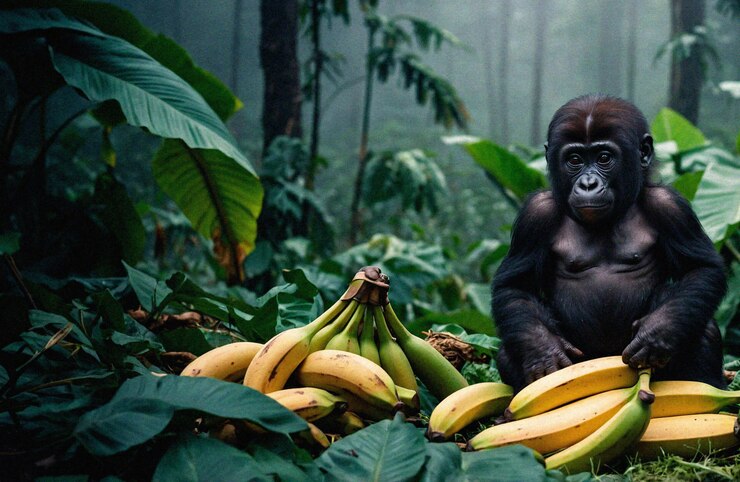Banana: b4hnuk08dew= Monkey

The relationship between bananas and monkeys has captivated the human imagination for centuries. This connection is not just a whimsical notion; it is rooted in biology, ecology, and culture. Let’s explore the deep ties that bind these two, delving into their nutritional significance, behavioral interactions, and the broader implications for conservation.
The Nutritional Value of Bananas
Bananas are one of the most widely consumed fruits globally, and their nutritional profile makes them a favorite among many species, including monkeys. They are rich in essential vitamins and minerals, particularly potassium, which is crucial for muscle function and nerve signaling. A medium-sized banana contains approximately 422 milligrams of potassium, making it a perfect energy source for active animals.
In addition to potassium, bananas are high in vitamin C, an antioxidant that supports immune function, and dietary fiber, which aids in digestion. The sugars in bananas—mainly fructose, glucose, and sucrose—provide a quick energy boost, making them especially beneficial for monkeys who engage in energetic activities like climbing and foraging.
Monkeys and Their Foraging Behavior
Monkeys are inherently curious and intelligent creatures, and their foraging behavior reflects this adaptability. While the diets of different monkey species vary based on their habitat and available resources, many are opportunistic feeders, taking advantage of whatever food sources are abundant.
In tropical rainforests, where many monkeys thrive, bananas are often found growing in clusters. Species such as spider monkeys and capuchins are known to forage for these fruits, using their dexterous hands to peel the skin and enjoy the sweet flesh. Observations have shown that monkeys can also exhibit problem-solving behaviors, such as using tools to access hard-to-reach bananas.
This foraging behavior is not only a survival tactic but also a social activity. Monkeys often forage in groups, allowing them to share resources and strengthen social bonds. The act of eating bananas can lead to playful interactions, with younger monkeys learning from their elders about how to peel and consume the fruit.
The Cultural Symbolism of Bananas and Monkeys
The image of a monkey eating a banana has become a staple in various forms of entertainment, from cartoons to movies. This portrayal often emphasizes the playful and mischievous nature of monkeys, reinforcing the idea that they are closely tied to this tropical fruit.
In many cultures, bananas symbolize happiness, abundance, and playfulness. Their vibrant yellow color and sweet taste evoke feelings of joy, making them popular in art and literature. The connection between bananas and monkeys has also been used in educational materials to engage children, fostering curiosity about wildlife and the natural world.
Conservation and Habitat Considerations
While the relationship between bananas and monkeys is delightful, it is essential to address the environmental challenges that threaten both. Habitat destruction due to deforestation, agricultural expansion, and urbanization poses significant risks to monkey populations and their food sources.
Many monkey species rely on diverse ecosystems where bananas grow naturally. The loss of these habitats not only decreases the availability of bananas but also disrupts the delicate balance of the ecosystem. As monkeys lose their natural food sources, they may venture closer to human settlements, leading to conflicts and further endangering their populations.
Sustainable agricultural practices can play a crucial role in preserving monkey habitats. For example, agroforestry, which integrates trees and shrubs into farming systems, can provide both bananas and a habitat for wildlife. By promoting biodiversity and creating a healthier ecosystem, we can ensure that monkeys continue to thrive alongside the bananas they love.
The Role of Ecotourism
Ecotourism offers a promising solution to the challenges faced by monkey populations. By creating economic incentives for local communities to preserve their natural habitats, ecotourism can promote conservation efforts. Tourists are often drawn to the chance to see monkeys in their natural environment, and this interest can lead to funding for wildlife protection initiatives.
Responsible ecotourism practices encourage sustainable interactions between humans and wildlife. Visitors can learn about the importance of conservation while enjoying the sight of monkeys foraging for bananas in their natural habitat. This awareness fosters a sense of responsibility toward protecting these animals and their environments.
Read also: Wordle Hint: Strategies to Solve the Daily Puzzle
Conclusion
The connection between banana: b4hnuk08dew= monkey is a rich tapestry woven from nutrition, behavior, culture, and conservation. As we appreciate the delightful sight of monkeys enjoying bananas, it is essential to recognize the importance of protecting their habitats. By fostering sustainable practices and promoting conservation efforts, we can ensure that future generations will continue to witness the joyful interaction between these playful primates and their favorite fruit. Through understanding and respect, we can contribute to a world where monkeys thrive and bananas flourish, celebrating the beautiful balance of nature.
